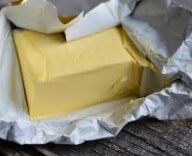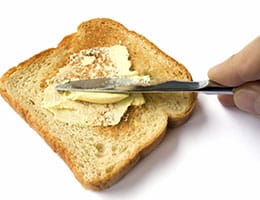 The notion of butter can refer to different products. The first meaning mentioned by the Royal Spanish Academy ( RAE ) in its dictionary refers to the substance that is obtained by beating, kneading and then allowing the cream extracted from milk to mature .
The notion of butter can refer to different products. The first meaning mentioned by the Royal Spanish Academy ( RAE ) in its dictionary refers to the substance that is obtained by beating, kneading and then allowing the cream extracted from milk to mature .
Lard, known as butter in some regions, is an emulsion consumed by humans in multiple ways. It can be spread on bread or cookies or used in the preparation of pastries and cakes, to name a few of the many possibilities.
One of the characteristics that butter brings to foods is softness, either when it is used so that the pasta does not stick or when it is incorporated into the preparation of a dough to give it a creamy and spongy consistency. There is a clear difference between a dough prepared simply with flour and water and one that also contains butter; Generally, the first is used in savory dishes such as pizza or bread, while the second is more typical of sweets or certain more elaborate savory pastries, such as empanadas.
The use of butter is also possible when preparing a sauce or a stir-fry, both instead of oil and to complement it. For example, if we sauté garlic, onion, red pepper and mushrooms only with oil, the result is less homogeneous although perfectly suitable for use as a dough topping; If we only add a tablespoon of butter when the ingredients have already softened, we will obtain a creamier and thicker consistency, more similar to a sauce than to a conventional stir-fry.
Cream and milk contain butterfat in the form of globules, which are surrounded by membranes composed of proteins and phospholipids. When you shake the cream, these membranes break and the fats gather into a single mass, separating themselves from other elements.
The fat of certain animals and fruits is also known as butter. Lard , which is obtained from the peritoneum or belly of the pig, is used for frying and as an ingredient. Cocoa butter , meanwhile, is a fat that comes from cocoa, which is extracted within the framework of the chocolate-making process.
 Peanut butter or peanut butter , on the other hand, is a paste that is made by processing roasted peanuts until they are finely ground. Many times other ingredients are added, such as vanilla or chocolate.
Peanut butter or peanut butter , on the other hand, is a paste that is made by processing roasted peanuts until they are finely ground. Many times other ingredients are added, such as vanilla or chocolate.
Unlike milk butter, peanut butter is usually used on its own, also to spread bread or to make sweet and sour cakes, but it does not require sugar or other ingredients that are common with the former. For example, at breakfast it is common to prepare slices of bread with milk butter and white or black sugar, jam or dulce de leche, while if we use peanut butter it is not necessary to add anything.
Vegetable shortening , finally, is an oil of vegetable origin that, through a hydrogenation process, solidifies. Its color and aroma are neutral. This represents an alternative to butter that is appreciated by vegans and strict vegetarians, those who refuse to consume products of animal origin.
With vegetable butter, one version of which is made from olive oil, it is possible to reproduce any dish that uses milk butter, although the results are not always equivalent. Despite this, vegans use it to spread toast, to accompany pasta and even to prepare doughs such as puff pastry.
